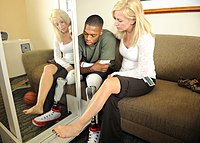
Photo from wikipedia
Objective. Transcranial magnetic stimulation (TMS) is an experimental therapy for promoting motor recovery from hemiparesis. At present, hemiparesis patients’ responses to TMS are variable. To maximize its therapeutic potential, we… Click to show full abstract
Objective. Transcranial magnetic stimulation (TMS) is an experimental therapy for promoting motor recovery from hemiparesis. At present, hemiparesis patients’ responses to TMS are variable. To maximize its therapeutic potential, we need an approach that relates the electrophysiology of motor recovery and TMS. To this end, we propose corticomuscular network (CMN) representing the holistic motor system, including the cortico-cortical pathway, corticospinal tract, and muscle co-activation. Approach. CMN is made up of coherence between pairs of electrode signals and spatial locations of the electrodes. We associated coherence and graph features of CMN with Fugl-Meyer Assessment (FMA) for the upper extremity. Besides, we compared CMN between 8 patients with hemiparesis and 6 healthy controls and contrasted CMN of patients before and after a 1 Hz TMS. Main results. Corticomuscular coherence (CMC) correlated positively with FMA. The regression model between FMA and CMC between five pairs of channels had 0.99 adjusted and a p-value less than 0.01. Compared to healthy controls, CMN of patients tended to be a small-world network and was more interconnected with higher CMC. CMC between cortex and triceps brachii long head was higher in patients. 15 min 1 Hz TMS protocol induced coherence changes beyond the stimulation side and had a limited impact on CMN parameters that are related to motor recovery. Significance. CMN is a potential clinical approach to quantify rehabilitating progress. It also sheds light on the desirable electrophysiological effects of TMS based on which rehabilitating strategies can be optimized.
Journal Title: Journal of Neural Engineering
Year Published: 2022
Link to full text (if available)
Share on Social Media: Sign Up to like & get
recommendations!